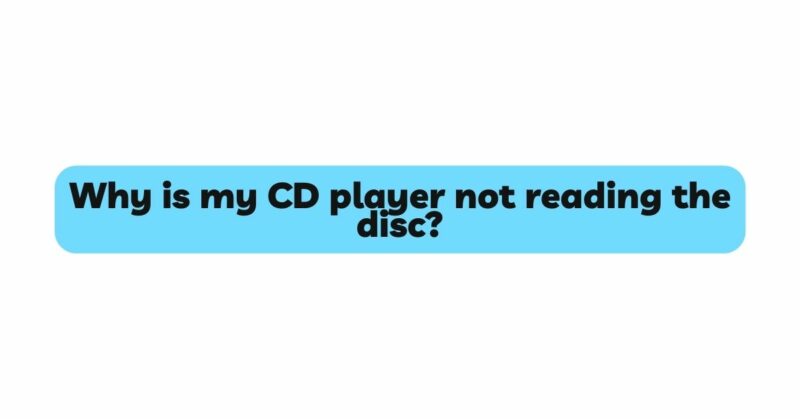Compact Disc (CD) players have been a staple in audio technology for decades, providing a reliable means of listening to music. However, encountering issues where your CD player refuses to read a disc can be frustrating. In this comprehensive article, we will delve into the various factors that can contribute to your CD player’s reading problems and guide you through troubleshooting steps to address these issues effectively.
**1. Dirty or Damaged Discs
One of the most common reasons why a CD player fails to read a disc is the presence of dirt, dust, fingerprints, or scratches on the disc’s surface. Even minor imperfections can disrupt the laser’s ability to accurately read the data. Start by inspecting the disc under a bright light to identify any visible damage. Gently clean the disc using a soft, lint-free cloth, wiping from the center to the outer edge. If there are scratches, consider using a specialized disc repair kit to address the issue.
**2. Laser Lens Blockage or Contamination
The laser lens is a critical component responsible for reading the data from the CD’s surface. Over time, dust and dirt particles can accumulate on the lens, leading to reading errors. A laser lens cleaning kit, available at electronics stores, can be a valuable tool in resolving this issue. These kits usually contain a cleaning disc equipped with tiny brushes that sweep away debris as the disc spins. Follow the manufacturer’s instructions carefully to ensure safe and effective cleaning.
**3. Disc Compatibility
CD players are designed to read various types of discs, but not all discs are compatible with every player. For instance, older CD players might struggle with reading rewritable CDs (CD-RW) or discs burned at high speeds. Make sure that the disc you’re using is compatible with your CD player’s specifications. If you suspect compatibility issues, try playing a commercially produced CD to determine whether the problem lies with the disc or the player itself.
**4. Laser Degradation
Over time, the laser diode that reads the CD’s data can degrade, leading to reading issues. This is a natural process, especially in older CD players. Signs of a degraded laser include increasingly frequent read errors or difficulty in reading certain portions of the disc. If your CD player is relatively old and experiencing these issues, it might be time to consider replacing the laser assembly or upgrading to a new CD player.
**5. Electronics and Circuitry
The electronics and circuitry within a CD player play a crucial role in accurately reading and interpreting the data from the disc. Malfunctions in these components can lead to reading errors. In some cases, issues might be related to faulty capacitors, resistors, or integrated circuits. However, diagnosing and repairing such problems require advanced electronics knowledge and specialized equipment. If you’re not experienced in electronics repair, seeking professional assistance is recommended.
**6. Firmware and Software Updates
Some CD players have digital features and software components that might require updates for optimal performance. Manufacturers periodically release firmware updates to improve compatibility and address bugs. Check the manufacturer’s website or consult your user manual for instructions on how to update the firmware. Keeping your CD player’s software up-to-date might resolve certain reading issues.
**7. Mechanical Problems
Mechanical issues within the CD player can hinder the proper spinning of the disc or the laser’s ability to track accurately. Gears, motors, and other moving parts can wear out over time. If you’re comfortable with electronics and mechanics, you might attempt to open the CD player and inspect its internals. Look for misaligned parts, damaged gears, or worn-out components. However, be cautious, as DIY repairs can void warranties and potentially cause further damage.
**8. Professional Assistance
If all else fails, and your CD player still struggles to read discs, it’s advisable to seek professional help. Contact the manufacturer’s customer support or find a certified electronics repair technician. These professionals have the expertise and tools to diagnose and address complex issues that might be beyond your scope.
Conclusion
Dealing with a CD player that refuses to read discs can be frustrating, but understanding the underlying causes can help you address the issue effectively. By following the troubleshooting steps outlined in this article, you can identify and resolve many common reading problems. Remember that some problems might require professional intervention, so don’t hesitate to seek assistance when needed. With proper care and maintenance, your CD player can continue to provide you with high-quality audio enjoyment for years to come.


